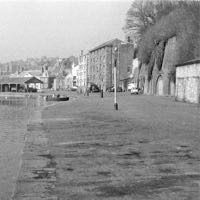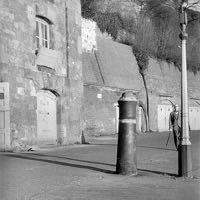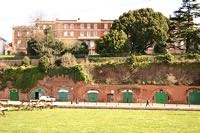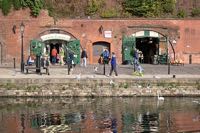
Quay Cellars
Page added 16th September 2016
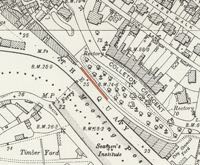 The small craft businesses that occupy the cellars on the quay are a popular place for browsing on a sunny day. When examining the reclaimed timber furniture, a glass workshop and carved work , how many think about the origin of the cellars, and some of the uses they were put to.
The small craft businesses that occupy the cellars on the quay are a popular place for browsing on a sunny day. When examining the reclaimed timber furniture, a glass workshop and carved work , how many think about the origin of the cellars, and some of the uses they were put to.
Before the basin opened in 1830, the first of the cellars was excavated in the red sandstone river cliff beneath Colleton Green. The first cellars were dug sometime in the mid 1820s, when the City Council widened the bank under the sandstone cliff, made it into a roadway and quay, and granted long leases to businesses wanted to excavate 60ft deep and 12ft high cellars. This was before King’s Wharf, the two large warehouses, were opened in 1834 and 1835, making the cellars the first private warehousing on the quay.
An advert for Baltic timber in April 1827 is the first that indicates the use of a cellar, when customers are invited to view the timber “in the Marsh and in (the) cellar near the quay.” A letter in the Flying post from 1828 by a London merchant, who intended to run a weekly return service between the Port of Exeter and London, stated that the “Buildings and Cellars on the Wharf then carrying on, (are) perfectly completed; and the advantage of the capability of the stowage of 30,000 Tons of Goods, under cover, must be obvious.” The 30,000 tons under cover seems very excessive for the capacity of the combined cellars, Custom House and any other warehouses not existing today. How many cellars were in operation is not clear, but the different sizes of the underground storage suggest they were excavated at different times.
Ten years pass before there is another mention in the local papers about the cellars. In 1838, a small comment in the Western Times said that gunpowder for the army was stored in the cellars, and perhaps the authorities should move it to the magazine at the Topsham Road Artillery Barracks.The storage of dangerous substances would become an issue in later years.
Mr Norris, in 1857, auctioned ‘forty hogshead of good family cider’ at the cellars. They were ideal for storing wine in a dark place, with constant humidity and temperature. Some were bonded cellars, a secure storage exempt from duty or tax until the contents were sold or exported. One cellar in 1838 was used for storing imports of sherry, port and bucellas (a white Portuguese wine).
Oil storage
Captain Thompson sent a letter to the City Council Committee in December 1876 after a large quantity of flammable petroleum was landed and stored on the quay–there was a regulation forbidding the storage of certain dangerous liquids in the cellars, although petroleum was not a liquid included in the Act. He considered that if it ignited it would destroy the contents of the cellars and destroy every vessel that lay on the quay. The candle and soap makers, J L Thomas and Co., who imported the load, had placed a night watchman to guard the barrels. Thompson suggested that flammable liquids be landed at the basin in future. Eight residents of Colleton Crescent also signed his letter. One member of the committee accused the residents of being overly concerned about the value of their properties and that they were too ‘fussy’. The Chairman replied that they should take the letter seriously as just a few days before, a barge of oil had caught fire in the Bight at Exmouth. It emerged at the meeting that gunpowder was still being stored in the cellars. The matter was passed on to the Navigation Committee, and probably forgotten
Time passed but the danger of storing oil products in the cellars did not pass. Leakages in 1881, were discussed by the council, when Mr Wilkinson asked if the oil leaking from the cellars and entering the river had been reported. Digging to install a lamp post on the quay had found the ground saturated in oil. Again, it was decided to pass the buck to the Navigation Committee.
Explosions and fire
The craft businesses in the cellars, which we like to browse on a Sunday afternoon, would have looked very differently on the morning of the 22 December 1882. Just after 7am there was an explosion, which the Exeter and Plymouth Gazette claimed could be heard “... for miles around, even as far as the hills of Pinhoe.” Oil in one of the cellars had ignited and in the words of the report:
“… the flames, on emerging from the store, flashed upward high above the cliffs and simultaneously swept across the road to the water. Almost directly opposite the store there was lying the schooner Jane, on board which were the master, his wife and son, and two apprentices. The first indication they had heard there anything was amiss with the noise of the explosion, and the rapidity with which the fire travelled may be gathered from the fact that the captain proceeding at once on deck to ascertain what had happened he found the store opposite converted into a fiery furnace, from whose jaws that belched forth an awful mass of fire, which swept everything before it, which had seized his vessel and was running its sides and up the rigging with fearful rapidity.”
The Captain, his family and crew escaped in the painter moored to the stern of the ship. The fire floated out and across the water, spreading a hundred yards along the quay, and to the other side of the river. The Jane was left to her fate, but the Clipper, moored just up river was towed to a place of safety by some workers. Both J L Thomas and E James Rowe and Co., stored Rosaline, benzoline and petroleum in the cellars, giving plenty of fuel for the fire. A second cellar erupted belonging to J L Thomas, and then a few minutes later a third.
The report best describes the scene at this time:
“… It seemed as if the cliff was a furious volcano which from its huge jaws belched forth fire and smoke that no man could approach. High up in the air shot the flames, illumining the whole city, while overhead the immense volumes of smoke spread in a dense black cloud. In the river there lay the unfortunate Jane in a bed of fire, for the blazing oil, as it fell into the water, surrounded the vessel and seemed to seek her destruction on all sides. As for the rigging, that had gone, and all that could be seen of masts and spars were just fiery outlines that could be discerned through the smoke.”
Imagine how puny the West of England and Norwich Union fire engines were against this inferno. Horse drawn, pumped by hand, with plenty river water at hand, they would have made little headway against the flames. The firefighters had to protect their faces and hands with wet sacking. Within an hour, thousands had gathered on the quay to watch the blaze, some diverted from their trip from the countryside to market to view “a grand sight.” Extra police were called to control the crowd.
A carrier on the Sidmouth Road saw the flames, and thought they were just a short distance away. The reflection of the fire was seen in Newton Poppleford, Budleigh Salterton and Haldon. There was not a single broken window in Colleton Crescent, even though the heat at the front doors was intense. A door from one of the stores was found on Haven Banks, and there were a few broken panes in St Thomas. One store belonging to Rowe and Co., contained 500 barrels of Rosaline oil, while a J L Thomas cellar contained petroleum. A Rosaline store between two blazing cellars belonging to Rowe and Co., was saved. The fire continued until the early afternoon, when it began to abate, and by 4pm the it was possible to approach the cellars and look in. It was still smouldering the next morning.
Investigations discovered that two workers with a safety lamp, went in the early morning, to fetch 20 barrels of oil. One stood about 25ft from the cellar doors while the other man opened the door. Vapour from the cellar escaped when the door was opened and was sucked into the lamp to ignite. There was a flash and explosion, knocking down the man holding the lamp, before they escaped the conflagration. It was estimated that 1,000 barrels of oil was lost, £2,000 of damage done, not including the Jane. The license to store oil products in the cellars was withdrawn in early January 1883.
The storage of larger quantities of petrol was moved to out of town sites, one being off Cowley Bridge Road, and new regulations preventing the use of wood barrels were introduced. Eventually, large oil storage tanks were built on Haven Banks, and small tankers such as the Ben Johnson and Esso Jersey became regular callers to Exeter. J L Thomas were released from the lease of their cellars in 1908.
Changing uses
After the removal of dangerous oils from the cellars, other businesses moved in. One one of the cellars, in 1904, was used for storing coal. Horse carts would load up at the quay and deliver to addresses around the city.
One of the cellars was used for many years as a council store, where the council stored the 16 cannon that were given as a gift for the Wellington Monument in Somerset. The cannon were landed at Exeter Quay in 1819, and then held by the city. They were later moved into the cellar and kept for 30 years, as security against unpaid freight and storage. Eventually, some were sold for scrap,two were embedded in the quay as mooring posts. The two cannon outside the Customs House are these from the quay side; they were placed on gun carriages for display.
In August 1917, the City Surveyor left his car parked on the quay to visit one of the cellars. While he was away, a high wind blew up, and caught the hood of the car, pushing it along the quay until it was tipped into six feet of water in the river.
The importance of the cellars diminished after the war, when they were used for various small businesses such as a panel beater, motor cycle engineers and builders. In the late 1980s, with the refurbishment of the two large warehouses, the cellars were let out to small craft businesses. On a summer day, their doors are pinned back and their wares displayed on the quay for passing custom–and hopefully, there is no chance of an explosion from one of them.
Sources: Various newspaper reports from the British Newspaper Archive.
│ Top of Page │
